Set Up Fingerprints
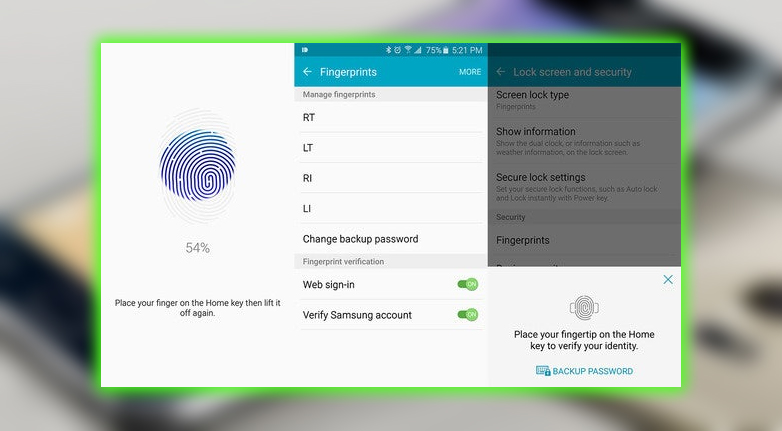
The fingerprint sensor is built into the home button, just like last year, but it has been vastly improved. You can just lightly press it to have your print recognized; no more swiping. The setup process takes a little longer, but it will only take a few minutes. To add fingerprints, go to your main system settings and enter Lock screen security > Fingerprints. You can add up to four prints by repeatedly tapping on the sensor. You should use your thumbs and index fingers on each hand.
Remember to tilt your finger back and forth to place different parts of it on the sensor. This will help the system recognize you more quickly and reliably. Also, make sure to get the very tip of each finger. While at it, you can configure the security settings to use your fingerprint to access your Samsung account. Fill in passwords in the stock web browser.
Activate Smart Lock
Even if fingerprints aren’t your thing, you should have some secure lock screen. There’s no reason to deal with it all the time. The Galaxy S6 supports the Lollipops Smart Lock feature, which you can access in the Lock screen security menu. It’s a level deeper in Secure lock settings. Here you can set geographic locations as trusted. Your phone will default to a standard swipe unlock at home, for example. The Galaxy S6 also supports trusted devices. You can keep it unlocked when connected to a Bluetooth accessory or NFC tag.
Change Your Home Screen grid Layout
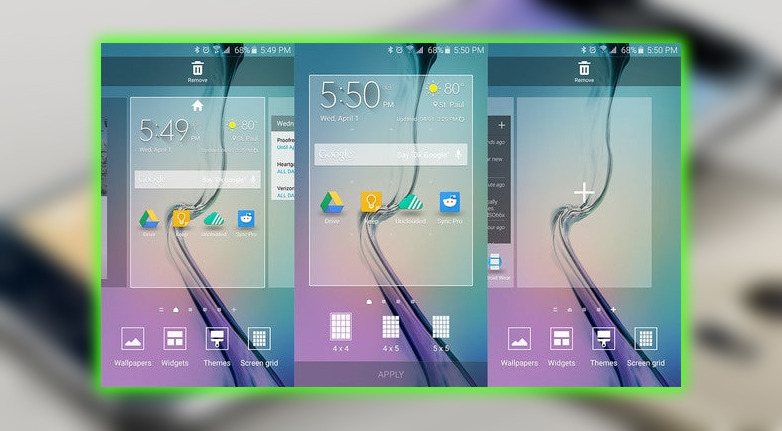
Samsung has added the ability to pick the home screen grid size for its stock TouchWiz launcher. You can use this to cram more icons onto each panel. You won’t get as many options as you would with a third-party home screen app. Simply long press on the home screen and tap Screen grid. The default is 4×4; it can be changed to 4×5 or 5×5. While you’re at it, a long press on the home screen. How you can add, remove, and rearrange home screen panels. You can set any panel as the main panel by tapping the home icon at the top of each page.
Remove the Briefing Screen
The Samsung Flipboard-powered news feed page is back this year, though it’s now called Briefing instead of My Magazine. You can use it if you want, but it’s strangely a laggy interface. The method to disable it has also changed on the Galaxy S6. A Long press on the home screen, then scrolls over to the Briefing panel on the far left. There’s a checkbox at the top, so go ahead and uncheck it, and you’re done. You can tap the checkbox again whenever you want to be reminded. Why you shut it off in the first place.
Disable Built in Apps Services
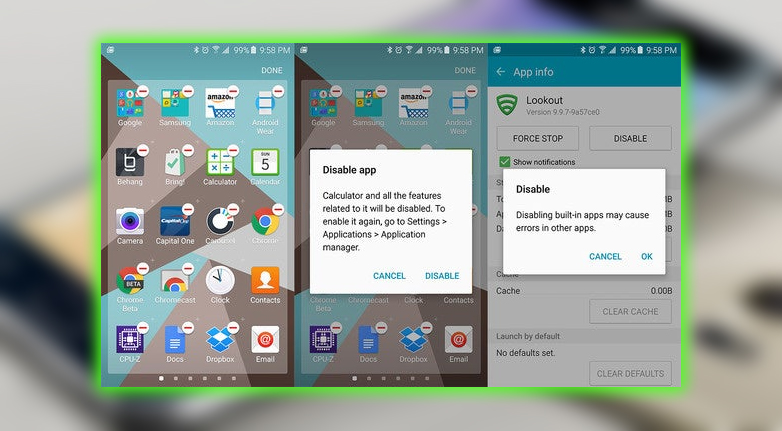
Samsung has reduced the number of built-in apps and services this year, but this is still Samsung we’re talking about. There’s a fair amount of cruft to clear out. Most of the pre-installed apps can be disabled. And don’t show up in the app drawer or run in the background. A few can be uninstalled entirely as well. There are two ways to go about this. You can open the app drawer and hit the edit button. Tap the minus sign on the apps you want to remove. They will be uninstalled if possible.
Otherwise, the system will disable them. The other method is to go into the main settings, open Applications > Application manager find the apps you want to disable or remove from the list. The info page will have suitable options when you tap on them. Some things you should get rid of include; Lookout, the Microsoft suite of apps, and Samsung Voice. Since Samsung Voice is no longer bound to the home button. All you need to do to do away with that particular feature. And you should. It’s still not very good.
Set Up ‘OK ’ Voice Detection
If you got rid of Samsung Voice in the above step. You should get Android’s much better voice command system set up. On the Galaxy S6, you can call up a voice query from any screen by saying OK. It just takes a few minutes of your time to configure. Head over to the app by long pressing the home button or launching it from the app drawer. Open the settings from the slide-out navigation drawer on the left, and open up Voice > OK detection. Toggle on the From any screen option to go through the setup process.
The phone will ask you to say OK a few times to learn your voice. Optionally, you can activate personal results, which also makes voice search features available from the lock screen. It’s a little less secure as someone could place calls or access your address. But it can be helpful for quick access to voice commands. Be sure to check out our complete list of Now voice commands.
Customize Notification Toggles
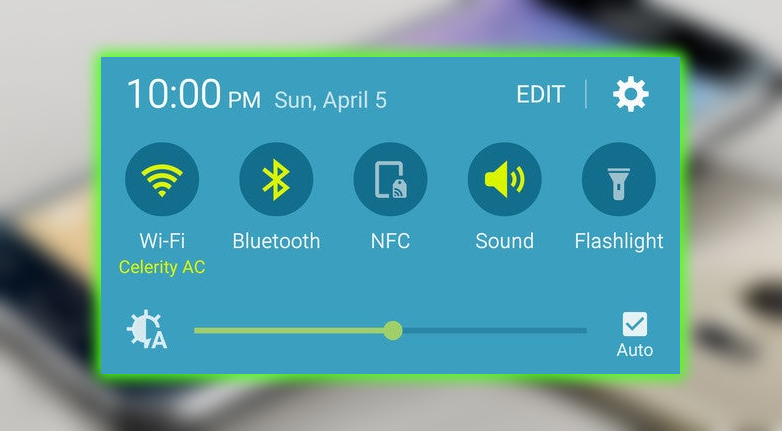
One of the most thoughtful aspects of TouchWiz. The configurable group of toggles at the top of the notification shade. This is an increasingly common feature in Android, but Samsung has been doing it for years. To change the order of the toggles, tap the Edit button at the top of the screen. From this menu, you can drag the buttons around as you like. The first group of five icons at the top of the screen will be seen. When you open the notifications, the second group is accessible by scrolling. Samsung has removed the expanded toggle list, so the remaining buttons are only available in the editing interface.
Customize Quick Settings
You might notice that using the Galaxy S6 involves poking around in the settings. You can make some of those menus easier by configuring Quick Settings. Note this is different from Quick Settings on stock Android, which refers to the toggles accessible from the notification shade. On the Galaxy S6, Quick Settings refers to the buttons at the top of your main Settings menu. It takes you to your most frequently used settings pages.
Open Settings, and you’ll see a few buttons pre-populated at the top. Tap the Edit button in the upper right to change what’s shown. You can access Wi-Fi, data usage, app notifications, fingerprints, and more. Tap Edit at the top of the existing Quick Settings. Tap the checkbox next to those where you want to reappear. Quick Settings supports a maximum of nine links of your choice.
Enable Download Booster
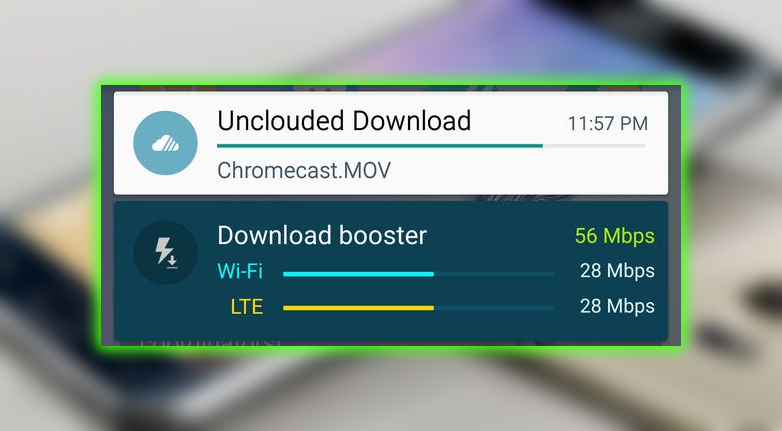
Download Booster was one of the most incredible features of the Galaxy S5; it’s back with the Galaxy S6. However, it’s off by default, buried in the settings. When enabled, Download Booster combines the Wi-Fi Ethernet connection to download large files faster than either connection could. To access Download Booster, open the main system settings and go to More connection settings > Download Booster. Please turn it on and get ready for faster downloads. If this setting isn’t present, guess what? Your carrier made Samsung remove it. In fairness, Download Booster can gobble up a lot of data if you’re not paying attention.
Configure Power Saving Modes
The Samsung Ultra Power Saving Mode. Will stretch a tiny bit of battery life into more than a day of use. The phone won’t be as much fun to use. But you’ll be able to take calls, send messages, and use a few apps. Ultra Power Saving Mode switches the device to a simplified black-and-white interface and disables most background services. Before turning it on with a nearly dead battery. You should fire it up while your battery is full to get things organized.
There’s a notification toggle to activate Ultra Power Saving Mode when your battery gets really low. Still, it can also be accessed from the battery settings menu. In Ultra Power Saving Mode, you can select a few apps as shortcuts on the home screen. There are a few, but you can choose from the stock browser, messaging, and others. There’s also a regular power-saving mode that’s a little less extreme. This setting reduces the screen brightness, slows the processor’s clock, reduces the display’s refresh rate, and shuts off vibration. This mode will switch on automatically when you reach a certain battery level between 50% and 5%. It’s a good idea to set this up. You’ll find it in Settings > Battery > Power saving mode.
Use the New Multi Window Mode
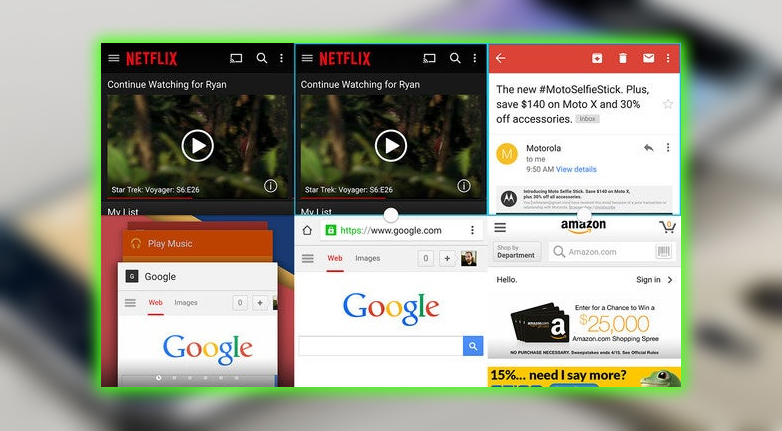
Samsung has changed the way Multi Window works on the Galaxy S6. It’s now tied into the app switcher UI instead of being something you need to explicitly startup. Apps that support Multi Window. Have a small twin rectangle icon in the corner when you have the app switcher open. You can tap this button to move that app to the top half of the screen. On the bottom half, you will get a similar stack of recent apps that also support Multi Window. With a scrollable list of all Multi Window apps.
You can also long-press the multitasking button to move the current app to the top half of the screen. If it’s a Multi Window-compatible app, pick another one for the bottom half. Once you’ve got both apps up. You can go back and forth between them and adjust the divider’s position. Giving one app or the other more room. Just hit back or home when you’re done to leave Multi Window mode.
Enable Screen Pinning
Screen pinning is a feature in Android 5.0. And makes it easy to hand your phone to someone else without worrying about them getting too nosey. With a few taps, you can lock the screen to a single app to keep your stuff private. But you need to enable it first. Screen pinning is found in Settings > Lock screen security > Other security settings. You’re looking for pin windows, which are way down at the bottom. You can pin any app by opening the app switcher, then tapping the little pushpin icon in the lower right. When there is a secure lock screen on your device. You can also require the Pin Number, pattern, or fingerprint when leaving the pinned application. This ensures you only will be able to unlock the phone and access other apps.
Pop up View
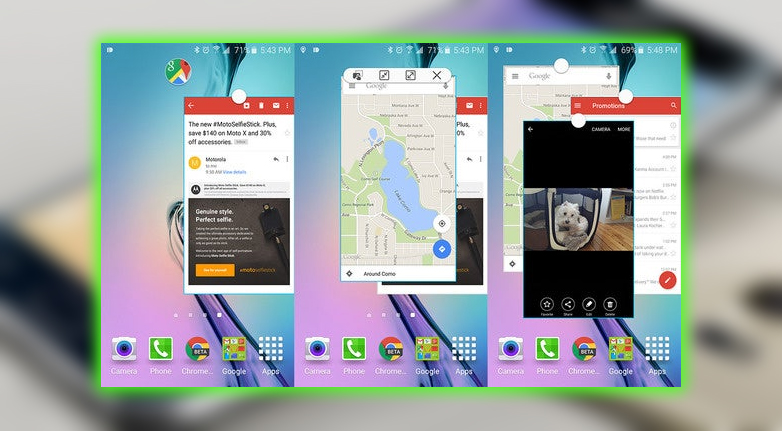
So now you’ve mastered Multi Window mode, but there’s something else of note technically connected to that. Samsung included a cool feature from the Note 4 called Pop-up View that works with any app that supports Multi Window, only those apps. You get a resizable floating app window to move around the screen. You can even have more than one. Minimize them to floating icons. There are three ways to go about this. Long press on an app in the multitasking UI, drag it down from the top right corner. When an app is open, or use the pop-up button when you have an app in Multi Window mode. You can arrange these floating windows however you want, drag content between them. And maximize them to full screen at any time.
Lock ‘Do Not Disturb’ Settings
The Galaxy S6 supports the priority notification that was in Android 5.0. But didn’t use the same terminology. If you’ve used another phone with Lollipop, you might need help figuring out what to look for. This doesn’t seem very clear, but okay. All the notification modes are under Do Not Disturb, which you’ll find in Settings > Sounds notification. If you turn on Do not disturb mode, you have the option of allowing exceptions or not. With no exceptions, the phone won’t make a peep, not even for alarms.
That’s the same as the None mode from other Android phones. If you allow exceptions like alarms, calls from specific numbers, and priority apps, that’s the same as Priority mode. Suppose you want to avoid manually toggling Do Not Disturb every evening. In that case, you can use this settings menu to set a schedule.
Try Some Themes
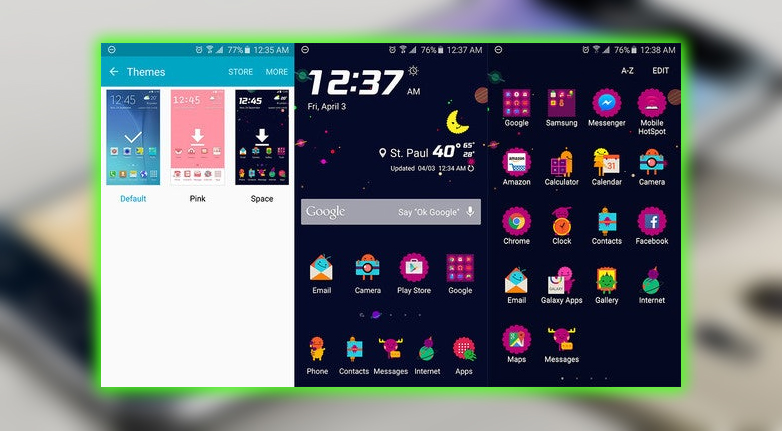
Samsung added a theme engine to Lollipop on the Galaxy S6, which is excellent. However, the themes available at launch are ugly, to put it kindly. Still, this is a neat feature you should be aware of going forward. In time, more themes are sure to arrive that are easier on the eyes. And could instantly make the Galaxy S6 more appealing. The theme settings are available in the main system settings or by long pressing on the home screen. You can download free themes, buy premium ones, and apply them to the phone. This is an all-or-nothing scenario; Samsung’s themes come with sounds, wallpaper, icons, fonts, and interface colors. The currently available are somewhat over the top, but there’s always hope for the future.














